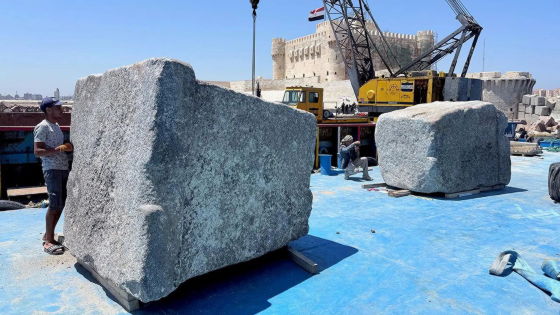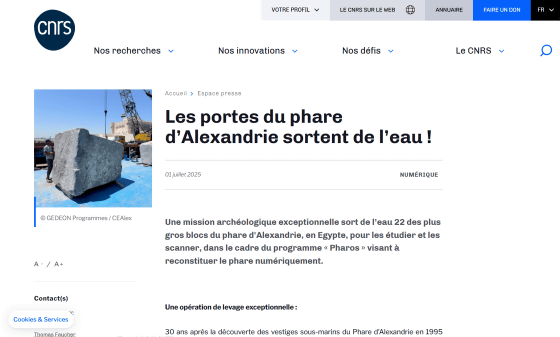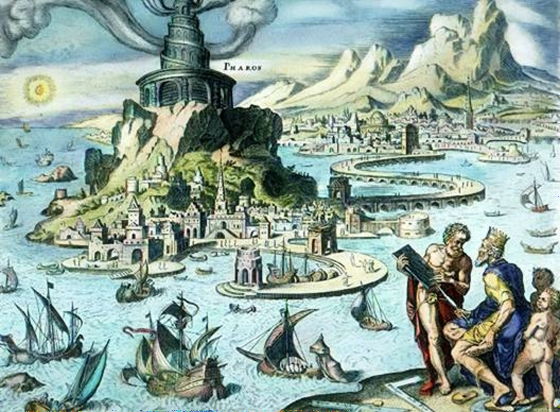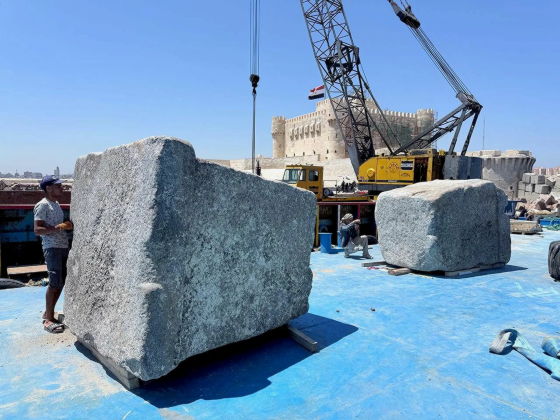Huge stones from the Lighthouse of Alexandria, a gigantic structure over 130 meters tall built in the 3rd century BC, are pulled out of the sea

Les portes du phare d'Alexandrie sortent de l'eau! | CNRS
https://www.cnrs.fr/fr/presse/les-portes-du-phare-dalexandrie-sortent-de-leau

Lighthouse of Alexandria rises again as 22 massive blocks resurface from the seafloor after 2,000 years | Archaeology News Online Magazine
https://archaeologymag.com/2025/07/lighthouse-of-alexandria-rises-again/
The Lighthouse of Alexandria was a large lighthouse built in Alexandria during the reign of Ptolemy I of the Ptolemaic dynasty in the 3rd century BC, and was designed by the Greek architect Sostratos of Cnidus .
It is said to have reached a height of 134m, and for a long time it was one of the tallest man-made structures in the world, alongside the Great Pyramid of Giza (about 147m). The Lighthouse of Alexandria was partially destroyed by an earthquake in 796, and then completely collapsed in subsequent earthquakes in 1303 and 1323. The stones left behind at the site were used to build the Fortress of Qait Bey in the late 15th century.

by Wikimedia Commons
In 1968, some of the stones used for the Lighthouse of Alexandria were discovered to be submerged on the seabed, and in 1994 a systematic investigation was carried out under the direction of French archaeologist
The expedition has identified more than 3,300 artifacts , including sphinxes, obelisks , columns and granite blocks, on the ocean floor. Over the past decade, more than 100 of these architectural fragments have been digitally scanned.
In July 2025, 22 new stones from the Lighthouse of Alexandria were raised from the seabed by the PHAROS project, led by archaeologist and architect Isabelle Hairy of the French National Center for Scientific Research (CNRS) .
The stones recovered include the lintels , pillars and threshold stones of the monumental entrance to the lighthouse, as well as a previously unrecorded fragment of a pylon , which is a combination of Egyptian and Greek architectural techniques and testifies to the cultural diversity of Hellenistic Alexandria.

by GEDEON Programmes / CEAlex
PHAROS is a project aimed at digitally reconstructing the Lighthouse of Alexandria, led by the CNRS and
Each stone, weighing up to 80 tonnes, will undergo detailed photogrammetric scanning before being handed over to volunteer engineers from the Dassault Systèmes Foundation, who will digitally analyse the stone fragments and virtually fit them together like pieces of a jigsaw puzzle in order to create a 'virtual replica of the Lighthouse of Alexandria.'

in Note, Posted by log1h_ik